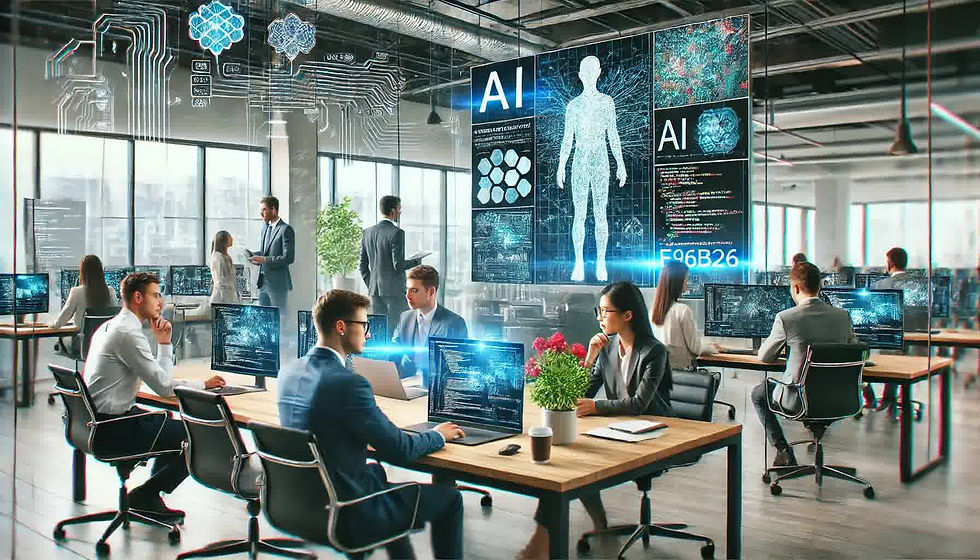01-26 Top IT Trends, Skills, and Tools to Advancements in IT: Tech Forecast 2025
- Jake Anderson

- Dec 1, 2024
- 5 min read
Updated: Mar 22
How Businesses and Professionals Can Thrive in an Era of Rapid Technological Evolution.
Top IT Trends - Advancements in IT are pushing the boundaries of what organizations and individuals can achieve. These advancements revolutionize industries by enabling more efficient operations, enhanced customer experiences, and new business models. However, significant complexity comes with great potential, requiring organizations to adopt more agile, informed strategies to harness these innovations effectively.
As these technologies mature, they bring opportunities and challenges, necessitating a shift in how businesses operate, and professionals approach their careers. Companies must rethink their strategies to stay competitive in a crowded digital marketplace, while professionals must refine their skill sets to remain relevant. This article delves into the vital tech trends shaping industries, the critical skills and tools IT professionals should prioritize, and actionable recommendations to thrive in this evolving digital era. From addressing the persistent challenges of cloud security to leveraging AI for personalized skill development and advancing sustainability goals, this forecast provides a comprehensive roadmap for confidently navigating the year ahead.

Top IT Tech Trends in 2025
Organizations will continue to adopt cloud and AI technologies but need help to drive value. Cloud and AI technologies are reshaping industries, offering unprecedented opportunities to streamline processes and create innovative solutions. However, many businesses need help to capitalize on these advancements fully. Aligning technological investments with broader business goals remains a hurdle, often compounded by skills gaps and the complexity of integrating cutting-edge tools into legacy systems. Effective change management and targeted workforce development will be crucial for organizations looking to maximize their returns on these investments.
Organizations will start thinking about sustainability. Sustainability is moving from a niche concern to a central business objective as environmental consciousness grows among consumers and stakeholders. Green computing practices, energy-efficient technologies, and circular IT strategies are gaining traction as organizations aim to reduce their carbon footprints. Beyond environmental benefits, sustainability initiatives offer competitive advantages by lowering operational costs and enhancing brand loyalty. Developing robust frameworks to measure and improve environmental impact will be vital to achieving sustainability goals while fostering innovation.
AI will accelerate existing security threats and introduce new risks. AI’s potential to enhance cybersecurity also poses significant risks, as malicious actors increasingly exploit AI-driven tools to develop sophisticated attacks. From advanced phishing schemes to deepfake fraud, the landscape of cyber threats is evolving at an unprecedented pace. Organizations must adopt AI-enhanced security measures, such as machine learning-based anomaly detection and predictive threat analytics, to stay ahead. Collaborative efforts to establish ethical and regulatory frameworks will also play a vital role in mitigating these emerging challenges.
Cloud security will remain a top challenge. Securing multi-cloud and hybrid environments is becoming increasingly complex, with misconfigurations and unauthorized access presenting persistent risks. As organizations expand their reliance on cloud services, the need for advanced security strategies, such as zero-trust architectures and automated compliance tools, becomes critical. Continuous employee training and leveraging AI-driven real-time threat monitoring solutions will strengthen defenses against evolving cyber threats.
AI will change the way people learn new skills. AI-powered educational platforms are transforming how individuals acquire knowledge, offering personalized learning paths, virtual tutors, and immersive experiences through augmented and virtual reality. These tools democratize access to high-quality education, enabling continuous skill development for professionals across industries. By analyzing user behavior and identifying skill gaps, AI-driven systems create tailored learning experiences that maximize engagement and retention, making lifelong learning more accessible.

Recommendations: How to Tackle the Trends
Pursue AI skills. The demand for expertise in AI technologies continues to grow, with machine learning, natural language processing, and AI ethics emerging as critical areas for professional development. Online platforms like Chauster UpSkilling Solutions offer many resources for building foundational knowledge and advanced expertise. Engaging in hands-on projects, hackathons, and open-source collaborations can further enhance practical skills, ensuring professionals can effectively leverage AI.
Boost data skills. Proficiency in data analytics, visualization, and governance is essential for navigating the increasingly data-driven IT landscape. Tools like Tableau, Power BI, and Apache Spark are becoming necessary for extracting actionable insights from complex datasets. Earning certifications in data science and staying abreast of trends like edge computing and real-time analytics will provide a competitive edge in a rapidly evolving field. The ability to interpret data and align findings with strategic business goals is a highly sought-after skill set across industries.
Learn Python - and other programming languages. Python’s versatility makes it a cornerstone of modern IT work, particularly in AI and data science. Expanding expertise to include additional languages like Java, Go, and Rust can open doors to opportunities in cloud development, cybersecurity, and systems programming. For aspiring developers, participating in coding boot camps, online tutorials, and community-driven projects can accelerate learning and build a robust portfolio.
Build up foundational technical and soft skills. The interplay between technical expertise and soft skills is crucial in today’s IT environment. Problem-solving, adaptability, and effective communication are essential for navigating complex projects and fostering collaboration across teams. Training programs, mentorship opportunities, and active participation in cross-functional initiatives can help professionals develop these competencies. Cultivating critical thinking and emotional intelligence also enables individuals to approach challenges with resilience and creativity, fostering long-term career growth.

Move Toward Cloud and AI Maturity with Proactive Strategies
Organizations must adopt proactive strategies to achieve cloud and AI maturity. This includes:
Investing in workforce training. Empowering employees with the knowledge and skills to work effectively with cloud and AI technologies is paramount. Offering access to certifications, interactive training modules, and mentorship opportunities ensures teams remain competitive and adaptable to evolving technological demands.
Emphasizing governance. Developing and implementing robust governance frameworks is critical for managing data integrity and ensuring compliance. Regular audits, clearly defined accountability structures, and adaptive policies help organizations navigate emerging challenges while maintaining operational excellence.
Adopting integrated platforms. Unified cloud and AI solutions simplify operations, enhance collaboration, and reduce costs. Investing in platforms that integrate seamlessly with existing systems fosters efficiency and accelerates the realization of strategic objectives.
Fostering collaboration. Encouraging cross-departmental partnerships helps align technological initiatives with overarching business goals. Collaborative efforts ensure that investments in cloud and AI deliver meaningful results, driving innovation and sustainable growth.
By addressing these areas, companies can unlock the full potential of cloud and AI technologies while mitigating associated risks. A proactive approach to strategy development ensures resilience and a sustainable competitive edge in the rapidly shifting digital landscape.
Two thousand twenty-five promises to be a year of unprecedented technological advancements and opportunities. Staying informed about trends like sustainability, cloud security, and AI-driven learning is essential for professionals and organizations looking to thrive. Integrating cloud computing, AI, and sustainable practices will define the next phase of digital transformation, creating pathways for innovation and long-term success.
By prioritizing skill development in areas like AI, data analytics, and programming while fostering soft skills like adaptability and communication, individuals can position themselves for a future-ready career. Organizations that focus on proactive strategies, workforce enablement, and robust governance will not only navigate the challenges of 2025 but also set the stage for sustained growth and technological leadership in the years to come.














Comments